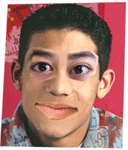2. Verbs associated with the face.
Use the -ing form of the verbs in the previous exercise to complete the sentences. Use each verb ONCE only.
| blink | smile | laugh | frown |
| yawn | stare | blush | cry |
5. Saying that something is not real.
Look at the table below. It shows how the adjectives false, fake and artificial are normally used to talk about things that look or seem real, but are not.
| Objects | Concepts or ideas or events | Valuable or expensive things | Intended to deceive | A substitute for something natural | |
| false | |||||
| fake | |||||
| artificial |
Note: You can say false teeth but not fake teeth.
Make sure you know the meaning of these words:
passport, antique, intelligence, teeth, promise, leg, eyelashes, tan, signature, light, name, bills, flavoring, fur, start, impression, jewelry
Now match the words with the correct adjective. Use the table above to help you.
7. The verb tell.
Look at these sentences:
Could you tell me when the next train leaves?
Police find it hard to tell when someone is lying.
In the first sentence, tell means to
communicate something.
In the second sentence, tell means to
know something.
In the following sentences, choose the correct option to show what tell means.
